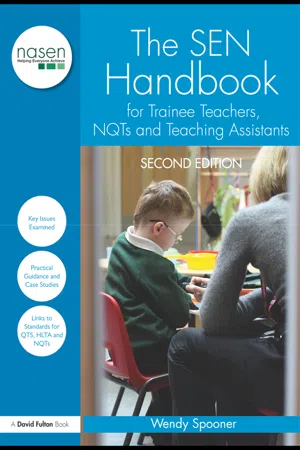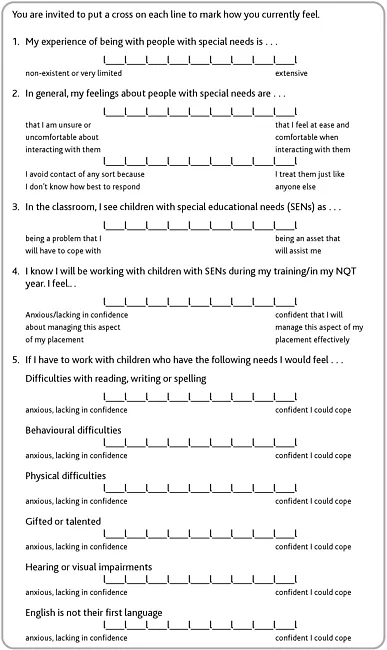CHAPTER 1
What are special educational needs?
In this chapter you will be introduced to the concept of special educational needs. A brief history of special educational needs up to the present will provide the context for considering how attitudes and values have changed over the last 150 years.
Q 2, Q10, Q15, Q18, Q19, Q25a C 3, C18, C19, C29a HLTA 3, 7, 9, 15 |
At various points as you read you will find questions or activities that are designed to help you to think about your own attitudes towards special educational needs and difference. Working through these will support you in meeting elements of professional standards for teachers (QTS and Core) and for Higher Level Teaching Assistant (HLTA) status.
Your personal starting point and attitude
I wonder what you feel is meant by a special educational need or SEN? This will, of course, depend largely upon your past experiences and some readers will already be familiar with the legal definition. However, it is worth stopping for a moment to consider what the term means to you at this particular time.
What point are you starting from when thinking about this question? You may, for example, have a child or a sibling with a disability or you may have worked as a learning support or teaching assistant (LSA or TA). In either case you will have direct experience, but perhaps within a limited field. For others, much of your knowledge and understanding may come from the media – from television documentaries, films or magazine articles. Your attitude to children with special educational needs will also be coloured by your own experiences. If a family member is autistic or dyspraxic, for example, you may feel very differently about social or behavioural difficulties from someone who has had no experience of this at all.
Your attitude will have a major impact on how you respond to children in the classroom as well as to their parents and other professionals, so it will be a recurrent theme in this book.
The personal audit in Figure 1.1 may help you to identify some of your feelings and attitudes. Put a cross on each line to mark what your current feeling or attitude is. You may like to come back to this at a later stage to see if anything has altered.
The legal definition of special educational needs
The legal definition is contained in the Education Acts of 1981, 1993 and 1996.
This definition excludes the needs of some children whom you personally may consider also have special educational needs, e.g. the gifted and talented or children for whom English is a second language (EAL). The Act makes it clear that children for whom English is an additional language should not be considered as having special educational needs for this reason alone, although some children with EAL may of course have learning difficulties as well. The needs of children with EAL, those who are gifted and talented and other children who have particular needs will be considered further in Chapter 3.
When reading the legal definition of special educational needs, what strikes you? Does it help you to understand better what a special educational need might be? Or are you feeling unsure as to what the definition is really saying? What, for example, does the phrase ‘significantly greater’ really mean? How significant does ‘significant’ have to be?
Take a few minutes to write down any queries and questions you still have about this definition and where you would like some clarification. Look back at this list from time to time and consider how your reading and further experience contributes to your understanding of the concept of special educational needs and the legal definition.
Historical context
We will be coming back to the definition but, before we do so, let us briefly look at the history of special educational needs in England. The history of special education is fascinating in its own right, mirroring, as it does, the history of social welfare. However, it also provides ...

